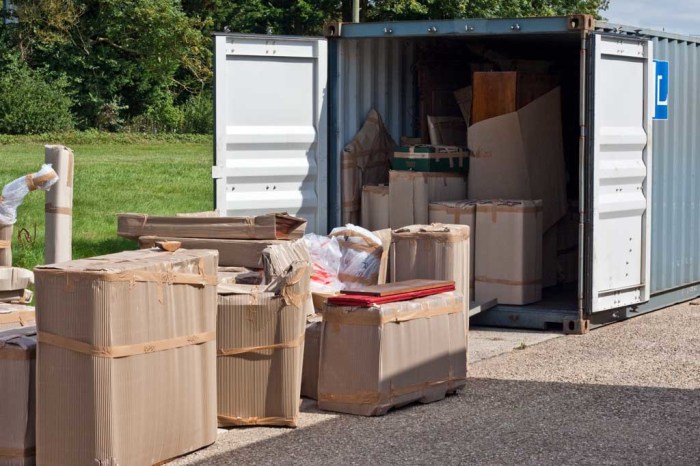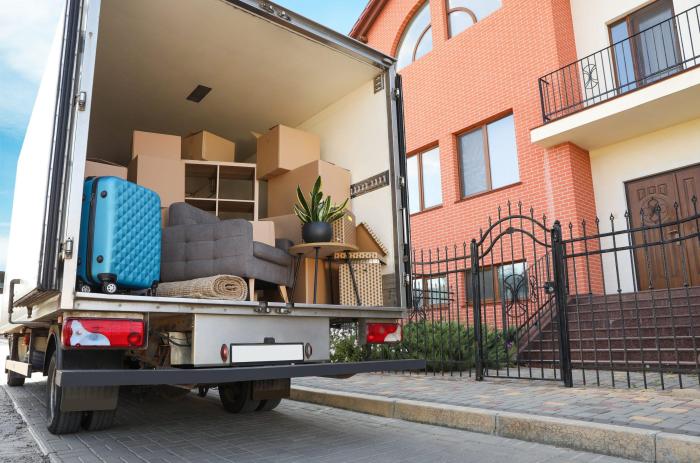Furniture shipping presents a unique set of challenges that require innovative solutions. This comprehensive guide delves into the intricacies of furniture shipping, providing practical strategies to overcome obstacles and ensure the safe and efficient delivery of your prized possessions.
From understanding the different types of furniture shipping services and their respective advantages to mastering packing and crating techniques, this guide equips you with the knowledge and expertise to navigate the complexities of furniture shipping with confidence.
Shipping Furniture: Challenges and Solutions

Shipping furniture presents unique challenges due to its size, weight, and fragility. Overcoming these hurdles requires careful planning and implementation of effective solutions.
Furniture shipping can be a hassle, but it doesn’t have to be. With harverty furniture , you can rest assured that your furniture will be delivered safely and on time. Harverty Furniture offers a wide range of shipping options to meet your needs, and their experienced team will work with you to ensure that your furniture arrives in perfect condition.
So whether you’re moving across town or across the country, harverty furniture has you covered.
Challenges
- Size and Weight:Furniture pieces can be bulky and heavy, making them difficult to transport and handle.
- Fragility:Furniture is often made from delicate materials like wood, glass, or fabric, which are prone to damage during shipping.
- Assembly:Some furniture requires assembly upon delivery, which can be time-consuming and complex.
Solutions
- Proper Packaging:Use sturdy boxes, bubble wrap, and foam inserts to protect furniture from damage.
- Specialized Shipping:Opt for shipping companies that specialize in handling furniture, ensuring proper handling and protection.
- Disassembly and Reassembly:Disassemble furniture when possible to reduce size and weight, and reassemble it at the destination.
- Insurance:Purchase insurance to cover any potential damage or loss during shipping.
Types of Furniture Shipping Services
Furniture shipping can be a daunting task, but there are a variety of services available to make the process easier. Each type of service offers its own advantages and disadvantages, so it’s important to choose the one that best fits your needs.
The most common types of furniture shipping services are:
- Full-service shipping:This type of service includes everything from packing and crating your furniture to transporting it to your new home. Full-service shipping is the most expensive option, but it’s also the most convenient.
- Partial-service shipping:This type of service includes some, but not all, of the services offered by full-service shipping. For example, you may choose to pack and crate your furniture yourself, but have it transported by a professional mover. Partial-service shipping is less expensive than full-service shipping, but it’s also less convenient.
- Self-service shipping:This type of service involves packing, crating, and transporting your furniture yourself. Self-service shipping is the least expensive option, but it’s also the most labor-intensive.
Factors to Consider
When choosing a furniture shipping service, there are a few factors to consider:
- Cost:The cost of furniture shipping varies depending on the type of service you choose, the distance your furniture is being shipped, and the size and weight of your furniture.
- Convenience:Full-service shipping is the most convenient option, but it’s also the most expensive. Self-service shipping is the least convenient option, but it’s also the least expensive.
- Time:Full-service shipping is typically the fastest option, but it can take longer if your furniture is being shipped a long distance. Self-service shipping is typically the slowest option, but it can be more flexible if you have a tight schedule.
Packing and Crating Techniques
Furniture packing and crating techniques are crucial for ensuring the safe transport of valuable pieces. These techniques involve utilizing specialized materials and equipment to protect furniture from damage caused by impacts, vibrations, and environmental factors.
The choice of packing and crating techniques depends on the size, shape, and fragility of the furniture being shipped. For smaller and less delicate items, bubble wrap, packing paper, and sturdy boxes may suffice. However, for larger, more fragile, or antique pieces, custom-built crates with foam padding, suspension systems, and climate control may be necessary.
Materials and Equipment, Furniture shipping
- Bubble wrap: Provides cushioning and protection against impacts.
- Packing paper: Used for wrapping and filling voids to prevent movement.
- Sturdy boxes: Double-walled cardboard boxes with reinforced corners offer protection from crushing.
- Custom-built crates: Constructed from plywood or wood panels, these crates provide maximum protection for large and fragile items.
- Foam padding: High-density foam sheets or blocks absorb impacts and prevent scratches.
- Suspension systems: Straps, springs, or air cushions isolate furniture from vibrations and shocks during transit.
- Climate control: For temperature-sensitive items, crates with climate control systems ensure a stable environment.
Transportation Methods for Furniture
Furniture shipping requires careful planning and selection of transportation methods to ensure safe and timely delivery. Various methods are available, each with its own costs, timelines, and reliability factors.
Land Transportation
Land transportation is a commonly used method for furniture shipping. It offers cost-effectiveness and flexibility, with options such as:
- Trucking:Trucks provide door-to-door delivery, making them convenient for smaller shipments. They are relatively cost-effective and offer flexibility in scheduling.
- Rail:Rail transportation is suitable for large-volume shipments over long distances. It is cost-effective but can be slower than other methods.
Water Transportation
Water transportation is an alternative option for shipping furniture internationally. It is typically used for large shipments and offers competitive costs, but can be slower than other methods:
- Ocean Freight:Ocean freight is the most common method for international furniture shipping. It involves shipping furniture in containers on large cargo ships. While cost-effective, it can take several weeks or months to reach the destination.
Air Transportation
Air transportation is the fastest but most expensive method for furniture shipping. It is suitable for high-value or time-sensitive shipments:
- Air Freight:Air freight involves shipping furniture on passenger or cargo planes. It offers the fastest delivery times but comes with higher costs.
Cost Comparison
The cost of furniture shipping varies depending on the method, distance, and size of the shipment. Generally, land transportation is the most cost-effective, followed by water transportation and then air transportation.
Timeline Comparison
The timeline for furniture shipping also varies depending on the method. Land transportation typically takes a few days to weeks, while water transportation can take several weeks or months. Air transportation is the fastest, with delivery times of a few days.
Reliability Comparison
The reliability of furniture shipping methods is generally high. However, factors such as weather, traffic, and customs clearance can affect delivery times. Air transportation is generally the most reliable, followed by land transportation and then water transportation.
Furniture shipping can be a daunting task, but it doesn’t have to be. If you’re looking for a reliable furniture store in Murphy, NC, you can’t go wrong with furniture stores in murphy nc . They have a wide selection of furniture to choose from, and their prices are unbeatable.
Plus, they offer free shipping on all orders over $1,000. So what are you waiting for? Start shopping for your new furniture today!
Insurance and Liability
Insurance is crucial in furniture shipping as it provides financial protection against unforeseen events that may cause damage or loss to the furniture during transit.Different types of insurance coverage are available, including:
Shipper’s Liability
Shipper’s liability insurance covers the legal liability of the shipper for any damages or injuries caused by the furniture during transit.
Carrier’s Liability
Carrier’s liability insurance covers the liability of the shipping carrier for any damages or loss to the furniture while in their possession.
Third-Party Liability
Third-party liability insurance provides coverage for damages or injuries caused to third parties due to the furniture during transit.
Shipping furniture can be a daunting task, but it doesn’t have to be. With the right company, you can rest assured that your furniture will arrive safely and on time. One company that specializes in furniture shipping is Harvertys Furniture . They have a team of experienced professionals who will handle your furniture with care.
Whether you’re shipping a single piece or an entire household, Harvertys Furniture can help you get your furniture where it needs to go.
Customer Service and Communication
In the furniture shipping industry, exceptional customer service is paramount. Effective communication is crucial throughout the process, from initial inquiries to post-delivery follow-ups. By establishing clear and consistent communication channels, businesses can build trust, manage expectations, and ensure customer satisfaction.
Tips for Effective Communication
- Establish Clear Communication Channels:Provide customers with multiple ways to reach the support team, such as phone, email, live chat, and social media.
- Respond Promptly and Professionally:Address customer inquiries and concerns promptly and courteously. Use clear and concise language, and provide timely updates on the status of shipments.
- Manage Expectations:Clearly communicate delivery timelines, costs, and any potential delays or issues. Keep customers informed throughout the process to avoid surprises.
- Personalize Communication:Address customers by name and acknowledge their specific needs. Use a friendly and professional tone to build rapport.
- Provide Regular Updates:Proactively inform customers about the progress of their shipments, including tracking information and estimated delivery dates.
- Follow Up After Delivery:Reach out to customers after delivery to ensure satisfaction and address any concerns or feedback.
Technology and Innovation in Furniture Shipping
The furniture shipping industry is undergoing a transformation driven by technological advancements. These innovations are revolutionizing the way furniture is tracked, monitored, and managed during transit, enhancing efficiency, transparency, and customer satisfaction.
Tracking and Monitoring
Real-time tracking systems allow shippers to monitor the location and status of their shipments at all times. This enables proactive decision-making, such as adjusting delivery routes or addressing potential delays, ensuring timely and reliable delivery.
Automated Management
Automated management systems streamline the shipping process, reducing manual errors and paperwork. These systems integrate with inventory management systems, allowing shippers to seamlessly manage orders, track shipments, and generate invoices, saving time and resources.
Data Analytics
Data analytics tools provide valuable insights into shipping patterns, performance metrics, and customer behavior. By analyzing this data, shippers can identify areas for improvement, optimize their operations, and enhance the overall customer experience.
Sustainable Practices in Furniture Shipping

In the modern era, environmental consciousness has become increasingly prevalent, extending to various industries, including furniture shipping. Sustainable practices have emerged as a crucial aspect of furniture shipping, driven by the need to minimize the industry’s environmental impact.
To promote sustainability in furniture shipping, several eco-friendly practices and materials have been adopted. These include:
Biodegradable and Recyclable Packaging
- Utilizing biodegradable or recyclable materials for packaging, such as cardboard, paper, and plant-based plastics, reduces waste and promotes eco-friendliness.
Energy-Efficient Transportation
- Employing energy-efficient transportation methods, such as rail or sea freight, can significantly reduce carbon emissions compared to air freight.
Sustainable Warehousing
- Adopting sustainable warehousing practices, such as using LED lighting, optimizing storage space, and implementing waste management systems, contributes to reducing the environmental footprint.
Ultimate Conclusion

Whether you’re a seasoned professional or embarking on your first furniture shipping endeavor, this guide provides invaluable insights and practical advice to help you achieve a seamless and stress-free experience. By embracing the latest technologies, adopting sustainable practices, and prioritizing excellent customer service, you can elevate your furniture shipping operations to new heights.
Essential Questionnaire
What are the most common challenges encountered in furniture shipping?
Furniture shipping poses unique challenges due to its bulky nature, susceptibility to damage, and high value. These challenges include ensuring proper packaging, selecting the appropriate transportation method, and navigating potential customs regulations.
How can I ensure the safe packing and crating of my furniture?
Proper packing and crating are crucial for protecting your furniture during transit. Use high-quality packing materials, such as bubble wrap, foam, and cardboard, to cushion and secure each item. Additionally, consider crating larger or fragile pieces for added protection.
What are the different types of furniture shipping services available?
Furniture shipping services vary based on the size, weight, and value of your items. Options include standard shipping, white glove delivery, and international shipping. Each service offers varying levels of convenience, speed, and cost.